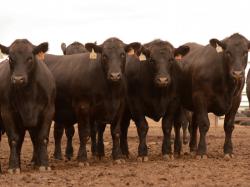Can't Get Enough Of The Best Beef
May 29, 2018 | 3 min to read

It’s a story that keeps surprising the beef community.
In 2018’s first quarter, cattlemen again set records for the percentage of carcasses grading Choice and Prime, and qualifying for the Certified Angus Beef ® (CAB®) brand. They kept breaking those records.
“It’s a little bit unbelievable,” says Mark McCully, the brand’s vice president of production.
Quality grades hit a high of 81.5% Choice and Prime in February, besting records just established in January and last fall.
Then, every single week in February set a new high for CAB brand acceptance, the share of black-hided cattle that made it into the brand after being presented to USDA graders for evaluation.
“The first question when we look at this kind of quality is, ‘Have we reached some point of market saturation?’” McCully says. “The reality is, that would be showing up in some really narrow Choice-Select spreads, and that’s just not what we saw through April. We’re seeing the demand continues to grow and that spread continues to stay strong.”
The first 16 weeks of 2018 averaged 34.9% CAB, compared to 30.3% for 2017. That’s an added 13,188 head branded each week.
“The idea that we’ve matured or hit some sort of a quality ceiling, I understand why people say it, but I don’t believe the economic signals support that,” he says.
The CAB boxed beef premium averaged $8.76 per hundredweight (cwt.) for the first quarter, compared to $9.19/cwt. for those months in 2017.
That’s down slightly, but the math tells the more complete story, McCully says. The certified head count increased by 20.4% (from 1.3 million to 1.6 million, or 300,000 head), but the spread only declined 4.7%, or $0.43.
“There’s a customer base out there today, people now accessing high-quality products that maybe just never thought they could before,” McCully says.
When you look at a greater slice of time, the story gets even richer.
Rewind to the first 16 weeks of 2010: 1 million head certified with a 24.1% CAB acceptance rate and a CAB-Choice spread of $6.20/cwt. Comparing 2018 to 2010, acceptance rate increased by more than 10 percentage points, certified head count rose by 55.5%. Even with that added supply, the CAB-Choice spread increased by 41.3%.
McCully says cattlemen have responded to the signals, which included a record $75 million in grid premiums paid for CAB qualifiers last year.
“The long-term trend has been driven by a focus on the carcass genetics,” he says. “It’s been an organized effort of managing that calf from the ranch to the packing plant.”
The widespread drought that affected many herds starting in 2011 and 2012 accelerated the genetic improvement.
“We’re still seeing the effects from cattle made through that expansion phase,” McCully says. “The way that happened was by keeping back better, younger cattle—rebuilding with heifers, and oftentimes breeding them to Angus bulls.”
Mother Nature will get less credit as time goes on.
“We’re probably at the end of that big cattle turnover that happened through the drought,” he says. “So it will still be a factor, but to a lesser degree moving forward.”
USDA’s updated maturity standards also played a minor role in this winter’s quality grade hike. A December change allowed cattle to qualify for the most youthful “A” maturity category based on either dentition or skeletal evaluation. Many branded beef programs, including CAB, revised their specifications to match.
“The science showed it was eating-experience neutral,” McCully says, noting it brought in more brand-eligible carcasses than they initially estimated. “A few cattle that were getting downgraded before are now able to achieve premiums.”
Beef buyers have taken the recent quality upswing and asked for more.
“They’re accessing more of the product, whether that’s Prime or CAB—or CAB Prime—and they like it, and their customers like it, so they’re bidding that product up,” McCully says.
“There was a time in my career where I would have said 30% [CAB acceptance] is probably where we’ll start maxing out. I don’t believe that’s the case anymore.”
The numbers show, “We’ve got opportunities to grow,” he says.
Source: Certified Angus Beef
